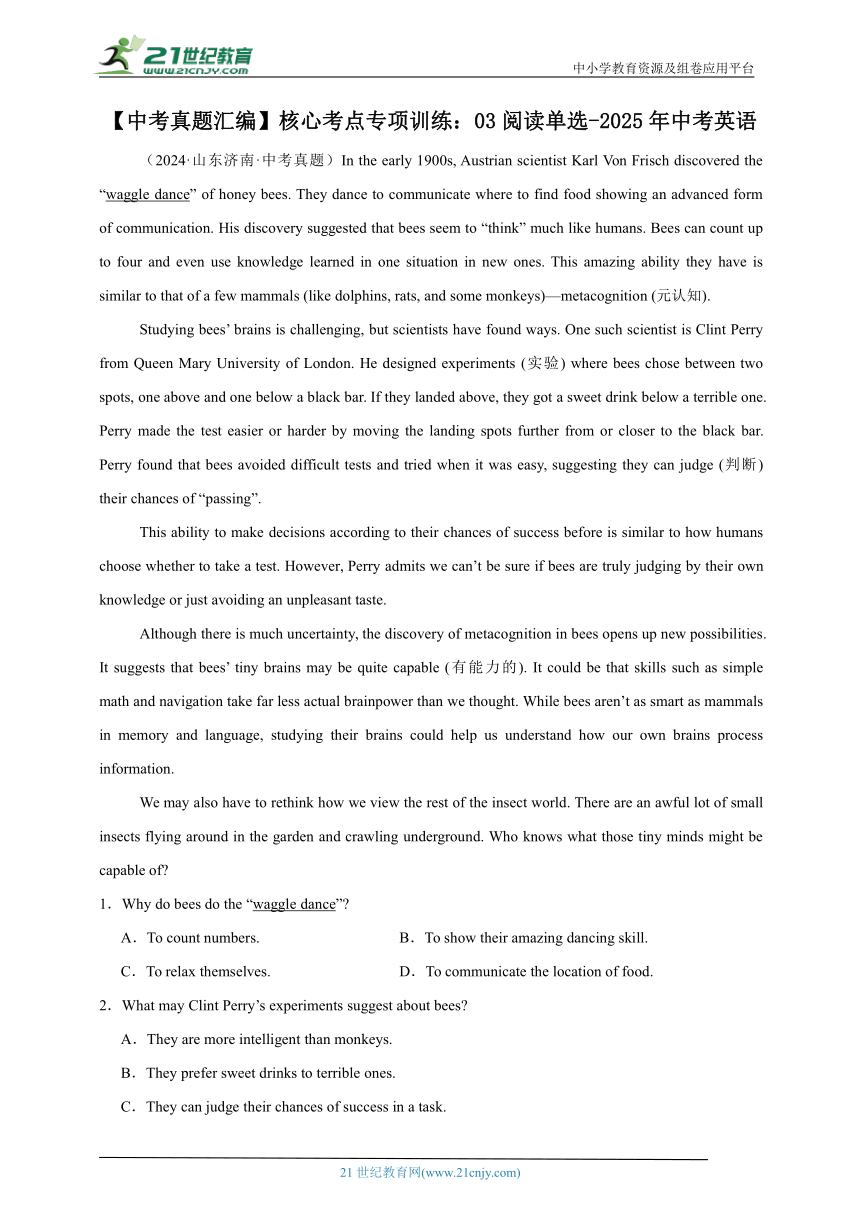
中小学教育资源及组卷应用平台 【中考真题汇编】核心考点专项训练:03阅读单选-2025年中考英语 (2024·山东济南·中考真题)In the early 1900s, Austrian scientist Karl Von Frisch discovered the “waggle dance” of honey bees. They dance to communicate where to find food showing an advanced form of communication. His discovery suggested that bees seem to “think” much like humans. Bees can count up to four and even use knowledge learned in one situation in new ones. This amazing ability they have is similar to that of a few mammals (like dolphins, rats, and some monkeys)—metacognition (元认知). Studying bees’ brains is challenging, but scientists have found ways. One such scientist is Clint Perry from Queen Mary University of London. He designed experiments (实验) where bees chose between two spots, one above and one below a black bar. If they landed above, they got a sweet drink below a terrible one. Perry made the test easier or harder by moving the landing spots further from or closer to the black bar. Perry found that bees avoided difficult tests and tried when it was easy, suggesting they can judge (判断) their chances of “passing”. This ability to make decisions according to their chances of success before is similar to how humans choose whether to take a test. However, Perry admits we can’t be sure if bees are truly judging by their own knowledge or just avoiding an unpleasant taste. Although there is much uncertainty, the discovery of metacognition in bees opens up new possibilities. It suggests that bees’ tiny brains may be quite capable (有能力的). It could be that skills such as simple math and navigation take far less actual brainpower than we thought. While bees aren’t as smart as mammals in memory and language, studying their brains could help us understand how our own brains process information. We may also have to rethink how we view the rest of the insect world. There are an awful lot of small insects flying around in the garden and crawling underground. Who knows what those tiny minds might be capable of 1.Why do bees do the “waggle dance” A.To count numbers. B.To show their amazing dancing skill. C.To relax themselves. D.To communicate the location of food. 2.What may Clint Perry’s experiments suggest about bees A.They are more intelligent than monkeys. B.They prefer sweet drinks to terrible ones. C.They can judge their chances of success in a task. D.They have excellent memory and language skills. 3.What is the value of studying bees’ brains A.It helps us study human brains. B.It reminds us to protect animals. C.It improves our own math abilities. D.It shows bees are our good friends. 4.Why does the writer end the text with a question A.To add information about bees. B.To get readers interested in insects. C.To show doubts about the research. D.To express opinions about animal testing. 5.What is the text mainly about A.Bees’ special communication skills. B.How bees process important information. C. ... ...
~~ 您好,已阅读到文档的结尾了 ~~

